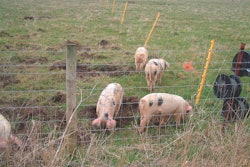
In South Korea, efforts are being intensified to keep out ASF, which spread to 14 Asian countries over the past two years.
Battling to control African swine fever (ASF) fully since September 2019, South Korea has introduced further measures aimed at reducing the risk of the virus entering the country through imported meat.
Six additional x-ray scanners have been installed at Incheon International Airport, reports Yonhap news agency. Bringing the total to eight machines, these will scan the luggage of incoming passengers to detect illegally imported meat products that could be infected with the ASF virus.
The penalty for those caught trying to smuggle in pork from ASF-infected countries stands at KRW5 million (US$4,180) for the first offense. For those detected on subsequent occasions, the fine is doubled.
Since the first ASF cases in South Korea in September 2019, the virus has been detected in a total of 655 wild boar, according to the same source. The last cases among domestic pigs were in October 2019.
Over the past week, 10 new cases of ASF among wild boar have been reported to the World Organisation for Animal Health (OIE). According to the South Korean agriculture ministry, all were found in Gyeonggi or Gangwon. In the north of the country near to the border with North Korea, these provinces are the location of all South Korea’s previous ASF-infected wild boar.
Most recent suspected cases of ASF in North Korea were reported in mid-May. Details of these outbreaks are scant.
More ASF cases in Russia’s Far East
At the end of June, two more wild boar in the Primorsky krai region tested positive for the ASF virus. Russia’s agriculture ministry reported the latest cases to the OIE over the past week.
Primorsky krai belongs to the Far Eastern region, where ASF cases have been reported periodically among both wild boar and domestic pigs since September of 2019.
Calls for relaxation of internal pork trade in the Philippines
In July 2019, the first cases of ASF were detected in pigs on the northern island of Luzon. Outbreaks have been reported to the OIE sporadically since then, with the most recent cases in June. Early this year, the disease was confirmed on the island of Mindanao.
In order to reduce the risk of further transmission of the disease, restrictions were introduced on the transportation of live pigs and pork products between the regions of the Philippines.
Now, the governor of Antique province in Western Visayas is urging the authorities in Minoro to allow the movements of Antique pigs through their ports. Pig farmers in ASF-free Antique want to take advantage of the higher pork prices in the Metro Manila area, according to the Philippine News Agency (PNA).
While a shortage of pork in Manila has pushed prices up as high as PHP170 (US$3.44) per kilo liveweight, producers receive just PHP90 locally in Antique. However, to reach the city on Luzon, Antique’s pigs need to pass through a port in Minoro to reach Luzon’s main shipping hub, Batangas.
According to another PNA report, Negros Occidental also remains ASF-free. A center for backyard pig production, the province has carried out inspections that led to the seizing of 3.3 tons of illegal pork and by-products. As part of the ordinance for ASF prevention drawn up in November last year, animal quarantine checkpoints have been set up on roads, and at the province’s airports.
With the most recent confirmed ASF on Mindanao in February, PNA reports that the island’s pig farmers are also eager to re-establish pork trade to Luzon.
While pork supplies there are tight and the retail price is up to PHP250 per kilo liveweight, consumers there have few options for their purchases. With other Asian nations also battling to control ASF, the only alternative is to buy frozen imported pork, which is less popular than fresh meat.
Pork price rise pushes up inflation in Vietnam
As a result of shortages linked to ongoing ASF outbreaks, pork prices have jumped sharply in Vietnam.
According to Vietnam News, a 68% rise in the cost of pig meat during the first half of 2020 pushed the overall index of consumer prices up by almost 3%. At 0.66%, the rise in the index for June was the highest monthly increase since 2016.
View our continuing coverage of the global African swine fever situation.

















